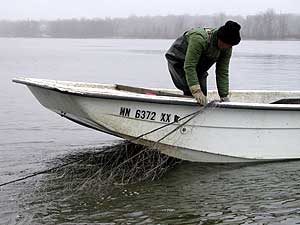|
Audio
Photos
Resources
Your Voice
|
Coming to a river near you: flying carp
November 12, 2003
 |
| A Minnesota DNR employee sets a 300-foot net near Hastings. The DNR is targeting Asian carp now that one has been discovered in Lake Pepin. (MPR Photo/Rob Schmitz) |
Hastings, Minn. — As a DNR fisheries specialist, Kevin Stoffer has done his fair share of work trying to educate the public about exotic species and the threats they pose to the state's ecosystems. All too often, he says, the information is met with blank stares. That's changed now.
"We've dealt with a lot of exotics, whether its zebra mussels, eurasian milfoil, purple loose strife, round gobis," says Stoffer. "I don't think anything has grabbed the public's attention quite like the Asian carp have, and I gotta think that's because they come flying out of the water and hit people."
The DNR is worried about how the Asian carp's voracious appetite will affect native species. However, the television images from Missouri and Illinois of the fish jumping more than 10 feet out of the water have earned the three species of Asian carp near-celebrity status.
 | |||
Stories of boaters who have been injured by the flying fish have added a touch of notoriety.
Up until a few weeks ago, Stoffer and his colleagues were setting nets on the Mississippi near the Iowa border to look for the fish. But that was before one was discovered on Lake Pepin, almost 100 miles upstream. Today, Stoffer is driving north along Highway 61 to set nets near Hastings, almost 70 miles further upstream.
He arrives at the boat launch where two colleagues are waiting for him in their boat. He jumps in and they set off towards their nets.
Just below Lock and Dam Number Two, they stop the boats and start pulling up a 300-foot mesh net. The day's catch is three common carp, and no sign of any Asian carp. Stoffer says looking for the fish at such an early stage is like finding a needle in a haystack.
"They're very good at avoiding nets. They have good eyesight and strong avoidance reactions. If one fish is in the net, they tend to sense that," says Stoffer.
 | |||
Downstream in Illinois, this isn't the case. According to the Illinois Natural History Survey, since 1994, commercial fishermen have caught more than 55 tons of Asian carp per year. Scientists estimate the fish are swimming upstream an average of 50 miles a year, and will soon become more abundant in Minnesota waters.
The carp devour plankton at the base of the food chain. Scientists on the Illinois River say they're already seeing reductions in native species. Some fear the fish will eventually take over the entire upper Mississippi ecosystem.
In response to the threat, the DNR is working with other states and federal agencies to examine ways of either preventing the fish from swimming further upstream or eliminating the species altogether.
Jay Rendall, the exotic species coordinator for the Minnesota DNR, says a proposal to build an underwater electric fence is popular. One has already been proposed along a wide stretch of the river near the Iowa border.
"We're looking at not just one place but several places, and perhaps it needs to be used in combination with other technologies," says Rendall.
 | |||
Other technologies include an underwater acoustic barrier that would emit bubbles that carry high-frequency sound waves, which have been shown to drive off the Asian carp. Phil Moy is a Wisconsin-based environmental consultant. He worked for eight years on an electric barrier at the mouth of the Illinois River. He's skeptical whether it would work on the much larger Mississippi River.
"What we don't know about that location, or other locations, are these less tangible effects or less controlled effects like the flood situations, the sediment situations, the debris. There might potentially be a problem with barges or navigation," says Moy.
Moy worries the Mississippi's infamous mud will swallow electrodes, rendering the barrier useless. He adds that the huge barges on the river might also disrupt the electrical field. Another concern is what the barrier would do to native species on the river.
As state and federal agencies scramble to find a way to eliminate the Asian carp, Moy poses a much simpler strategy: If you can't beat 'em, well, eat 'em.
"These are not bottom feeders, they are feeding up in the water column. They're eating plant plankton and animal plankton, so they're not going to be picking up that muddy flavor people tend to connotate with the common carp," says Moy.
Moy says an Illinois food processing company recently signed a contract to purchase two million pounds of Asian carp for human consumption. He says breaded Asian carp patties are delicious.
The Minnesota DNR hopes to finish a feasibility study that will address the Asian carp problem in a few months. They plan to present the study to the state Legislature next March.
|
News Headlines
|
Related Subjects
|
